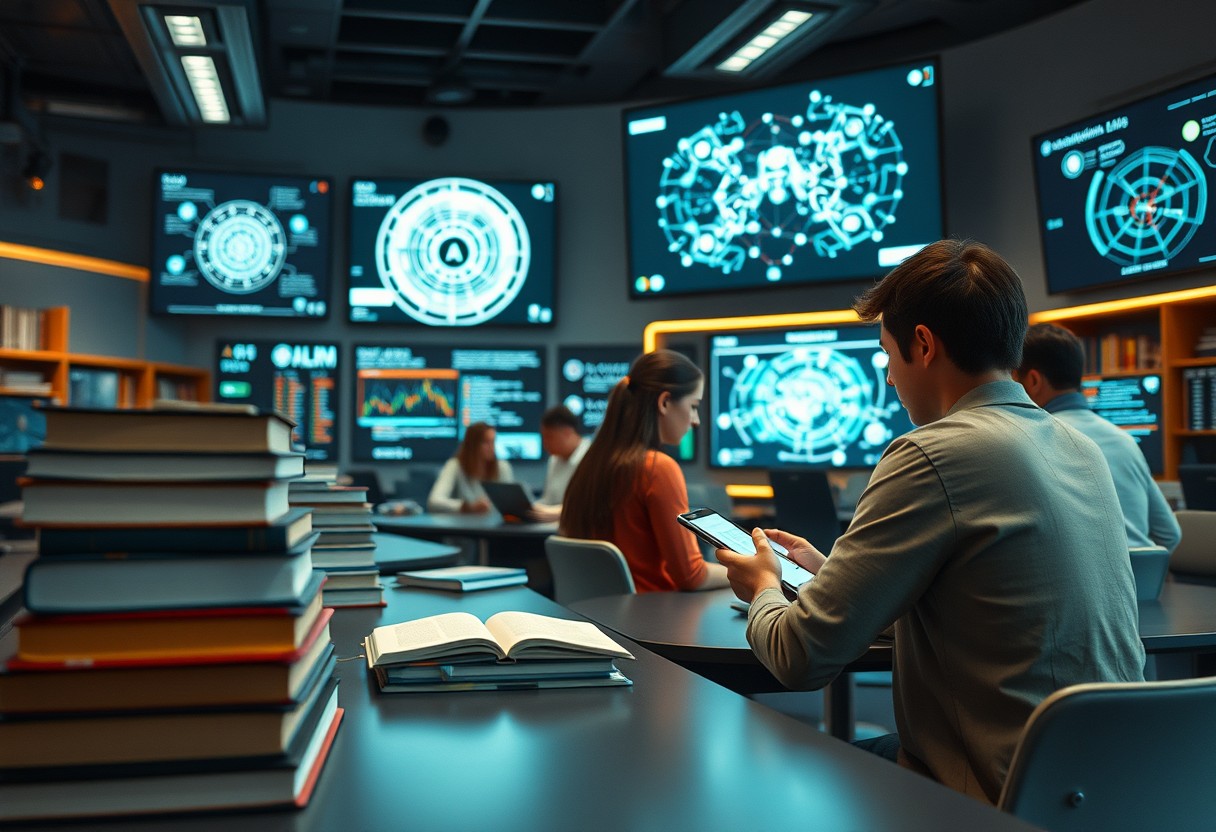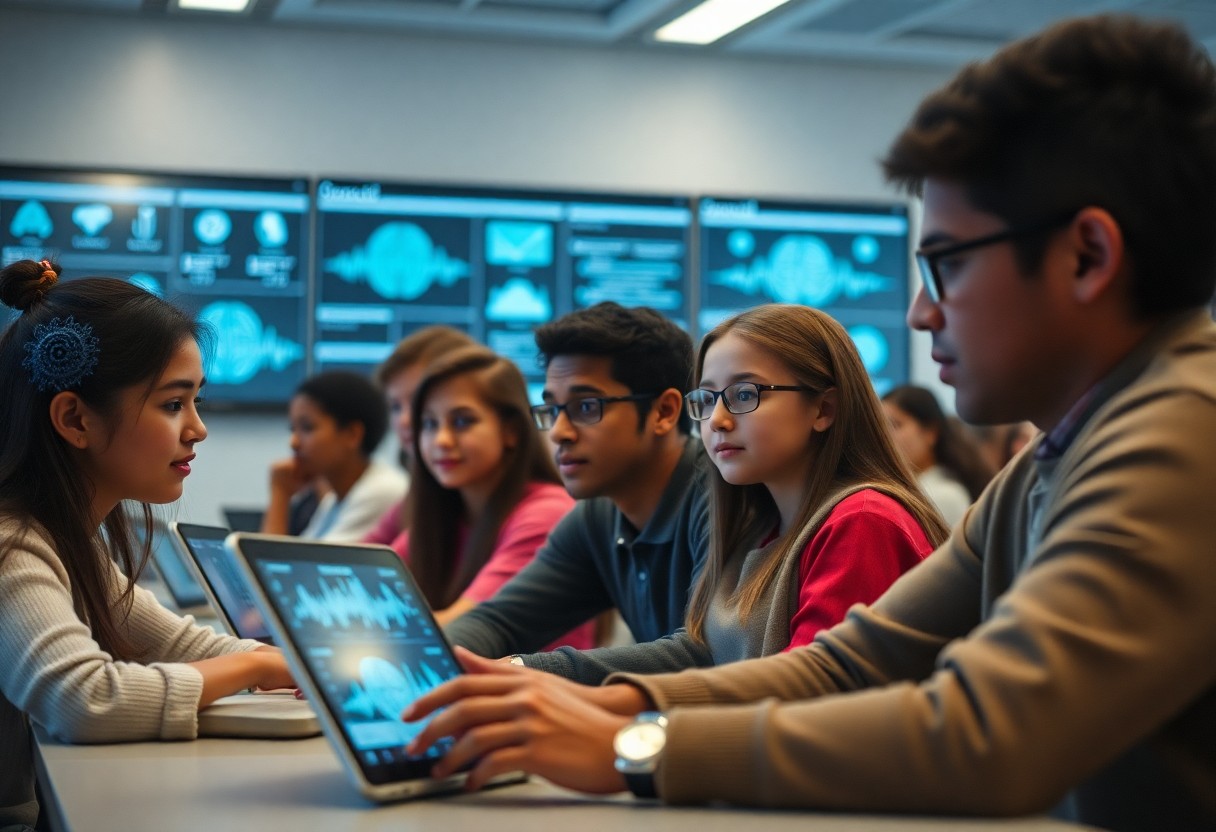Teaching has undergone a dramatic evolution with the emergence of Artificial Intelligence (AI) in education. This article researchs into the innovative ways in which AI is reshaping traditional teaching methods, from personalized learning experiences to data-driven insights. By exploring this intersection of technology and pedagogy, we uncover the potential benefits as well as the challenges that arise when AI meets the classroom. Are we on the brink of a revolution in education, or is there cause for caution in embracing these advancements?
The Evolution of Teaching Methods
The traditional methods of teaching have undergone significant changes over the years with the advancement of technology. From the use of chalkboards to smartboards, educators have embraced new tools to enhance the learning experience for students.
From Chalkboards to Smartboards
The introduction of smartboards in classrooms has revolutionized the way teachers engage with students. These interactive whiteboards allow for multimedia presentations, real-time collaboration, and dynamic content delivery. This shift from traditional chalkboards to smartboards has enabled teachers to create more dynamic and engaging lessons, catering to different learning styles and keeping students actively involved in the learning process.
The Rise of EdTech and AI-Assisted Learning
Learning technologies such as educational apps, online learning platforms, and AI-assisted tools have gained popularity in recent years. These innovations provide personalized learning experiences, instant feedback, and data-driven insights to both teachers and students. By leveraging AI algorithms, educators can better understand student performance, tailor instruction to individual needs, and optimize the learning outcomes.
Plus, the use of AI in education has the potential to revolutionize the way students learn, offering adaptive learning pathways, virtual tutors, and personalized recommendations for further study. However, it is crucial to consider ethical implications, data privacy concerns, and the digital divide that may arise with the widespread adoption of AI in education.
The Role of AI in Modern Education
It goes without saying that the integration of artificial intelligence (AI) in modern education is revolutionizing the way students learn and teachers instruct. AI technology is reshaping the traditional teaching methods by offering personalized learning paths and intelligent tutoring systems to cater to individual needs and abilities.
Personalized Learning Paths
To enhance the learning experience, AI algorithms are designed to create personalized learning paths for students. By analyzing the strengths and weaknesses of each student, AI can tailor the curriculum to suit their learning pace and style. This individualized approach not only ensures better understanding and retention of the material but also fosters a deeper engagement with the subject matter.
Intelligent Tutoring Systems
For a more interactive and dynamic learning experience, intelligent tutoring systems are becoming increasingly popular in modern education. These AI-driven systems can provide real-time feedback to students, helping them track their progress and identify areas for improvement. By simulating a one-on-one tutoring experience, AI tutors can adapt to the student’s learning speed and customize lessons accordingly.
It is evident that intelligent tutoring systems have the potential to revolutionize the education sector by offering personalized guidance to students, regardless of their learning capabilities. With the ability to provide instant feedback and adaptive learning experiences, AI is paving the way for a more efficient and effective educational framework.
The Benefits of Blended Learning
Combining Human Touch with AI Efficiency
Some educators argue that one of the key benefits of blended learning, which integrates traditional teaching methods with AI technology, is the ability to combine the human touch of a teacher with the efficiency of AI. Human teachers bring empathy, understanding, and personalized attention to the learning process, while AI can provide instant feedback, adapt learning materials to individual student needs, and offer additional support outside of classroom hours.
Enhancing Student Engagement and Motivation
One significant advantage of blended learning is its potential to enhance student engagement and motivation in the learning process. One of the ways this is achieved is through the use of interactive AI tools and platforms that offer gamified learning experiences, real-time progress tracking, and personalized challenges to keep students motivated and invested in their own learning journey.
Plus, by utilizing AI to analyze student data and behavior, educators can gain valuable insights into each student’s learning preferences and challenges, allowing for more targeted interventions and support to help every student succeed.
The Challenges of Implementing AI in Education
Once again, as with any technological innovation revolutionizing an industry, implementing AI in education comes with its own set of challenges. While the potential benefits of AI in the classroom are numerous, there are also significant obstacles that need to be addressed for successful integration.
Addressing Teacher Concerns and Skepticism
Implementing AI in education can often be met with resistance from teachers who fear that AI technology may replace them in the classroom. It is important to communicate to educators that AI is meant to enhance, not replace, traditional teaching methods. Teachers play a critical role in guiding and mentoring students, and AI should be viewed as a tool to assist them in their efforts, offering valuable insights and support.
Ensuring Equity and Access for All Students
On the path to incorporating AI in education, one of the most crucial challenges is ensuring that all students have equal access to this advanced technology. Ensuring that AI tools are accessible to students from diverse socioeconomic backgrounds is important to prevent the deepening of existing educational disparities. Additionally, special attention must be paid to guarantee that AI algorithms are free from bias and do not perpetuate inequalities.

AI-Powered Adaptive Assessments
Many educational institutions are integrating AI-powered adaptive assessments into their teaching methods to enhance the learning experience for students. These assessments utilize artificial intelligence algorithms to tailor questions based on the student’s performance, providing a more personalized and accurate evaluation of their knowledge and skills.
Revolutionizing Testing and Evaluation
Revolutionizing the traditional testing and evaluation methods, AI-powered adaptive assessments offer a dynamic approach that goes beyond standard one-size-fits-all tests. By analyzing each student’s responses in real-time, the AI system can identify areas of strength and weakness, adapting the difficulty level of questions to provide a customized assessment. This not only increases the accuracy of the evaluation but also engages students in a more interactive and personalized learning process.
Providing Real-Time Feedback and Insights
RealTime feedback and insights are crucial components of AI-powered adaptive assessments. As students complete the assessments, the AI system instantly analyzes their responses and provides real-time feedback on their performance. This immediate insight helps students identify their strengths and weaknesses, allowing them to adjust their learning strategies accordingly to improve their overall understanding of the material.
To further enhance the educational experience, educators can utilize this real-time data to tailor their teaching methods to meet the specific needs of each student. By identifying areas where students may be struggling, teachers can provide targeted support and resources to help them succeed. This individualized approach to learning is revolutionizing the traditional classroom setting, creating a more adaptive and effective learning environment for all students.
Intelligent Virtual Learning Environments
Unlike traditional teaching methods, Intelligent Virtual Learning Environments (IVLEs) leverage artificial intelligence to enhance the educational experience. These environments are designed to simulate real-world scenarios and provide personalized learning opportunities for students. IVLEs use advanced algorithms to analyze student performance and adapt the learning content accordingly, making the educational process more effective and engaging.
Creating Immersive and Interactive Experiences
Interactive learning experiences are imperative in engaging students and promoting active participation. IVLEs incorporate simulation technologies and virtual reality to create immersive educational environments where students can interact with the content in a hands-on manner. This enables students to engage with the material on a deeper level and apply their knowledge in practical situations, enhancing their learning experience.
Fostering Collaborative Learning and Social Skills
The integration of AI in virtual learning environments also promotes collaborative learning and social skills development among students. IVLEs facilitate group projects and interactive activities that require students to work together towards a common goal. This not only enhances their communication and teamwork skills but also fosters a sense of community and shared learning experience.
Collaborative learning in IVLEs also encourages students to exchange ideas, provide feedback to their peers, and engage in discussions, promoting a holistic approach to learning. By fostering collaboration and social interaction, IVLEs prepare students for the dynamics of the modern workplace, where teamwork and communication skills are highly valued.
The Future of Teacher Training and Development
Keep pace with the rapid advancements in technology, teacher training and development programs must evolve to equip educators with the necessary skills to thrive in an AI-infused classroom. As AI continues to transform education, teachers need to adapt and embrace new strategies that blend traditional teaching methods with innovative technologies.
Preparing Educators for an AI-Infused Classroom
Development of educators for an AI-infused classroom involves more than just learning how to use new tools. It requires a fundamental shift in mindset, focusing on collaborative learning, creativity, and critical thinking. Teachers must be supported in developing their digital literacy and understanding of AI technologies to effectively integrate them into their teaching practices.
Upskilling and Reskilling for the Digital Age
AIInfused the digital age, educators face the challenge of upskilling and reskilling to meet the demands of a rapidly changing technological landscape. Traditional professional development programs may no longer suffice, as teachers need in-depth training on AI applications, data analysis, and personalized learning tools. Continuous learning and adaptability are crucial for educators to stay relevant and make the most of AI in education.
As we look towards the future of teacher training and development, it is imperative to prioritize the integration of AI technologies into educational practices. By investing in the upskilling and reskilling of educators, we can ensure that teachers are well-prepared to harness the potential of AI in enhancing student learning outcomes and shaping the future of education.
AI-Driven Content Creation and Curation
All educators are familiar with the time-consuming task of creating and curating educational resources. Fortunately, AI technology has been making significant strides in streamlining this process, offering a more efficient and effective way to develop learning materials.
Streamlining Educational Resource Development
For educators, AI tools can assist in generating content tailored to specific learning objectives and student needs. Machine learning algorithms can analyze vast amounts of data to identify patterns and trends, helping educators create personalized resources that cater to individual learning styles. This not only saves time but also ensures that the content is more likely to resonate with students, enhancing engagement and comprehension.
Ensuring Quality and Relevance in Digital Content
On the flip side, the sheer volume of digital content available online can be overwhelming for educators trying to find the most relevant and high-quality materials for their lessons. AI-powered content curation tools can help sift through this vast sea of information, highlighting the most important and relevant resources based on specified criteria. This can save educators valuable time and ensure that the materials they use are up-to-date and accurate.
Addressing Ethical Concerns and Biases in AI Education
Despite the numerous advantages and innovations that AI brings to the field of education, there are also significant ethical concerns and biases that need attention. As AI technologies become more integrated into educational settings, it is imperative to address these issues proactively to ensure that all students have equal opportunities for learning.
Mitigating Unintended Consequences and Discrimination
With the increasing use of AI in education, there is a risk of unintended consequences and discrimination. AI algorithms can inadvertently perpetuate biases present in the data they are trained on, leading to unequal treatment of students. To mitigate these risks, it is crucial to continuously monitor and evaluate AI systems to detect and address any biases that may arise. Implementing diverse and inclusive training data sets can help reduce the chances of perpetuating harmful stereotypes and biases.
Promoting Transparency and Accountability
Accountability is key when it comes to addressing ethical concerns in AI education. Educational institutions and AI developers must be transparent about the algorithms and data sets used in educational technology. Providing clear explanations of how AI systems make decisions and being open about the potential limitations and biases can help build trust with students, teachers, and parents. Additionally, establishing ethical guidelines and standards for the use of AI in education can ensure that these technologies are developed and implemented responsibly.
Ethical considerations in AI education are crucial for creating a fair and inclusive learning environment. By addressing biases, promoting transparency, and holding stakeholders accountable, we can harness the power of AI to enhance traditional teaching methods and provide a more equitable education for all students.
The Impact of AI on Special Education and Inclusive Learning
Your educational experience can be significantly influenced by the integration of AI technologies in the classroom, particularly in special education and inclusive learning. AI has the potential to revolutionize the way educators tailor support for students with disabilities, enhance accessibility, and promote active participation.
Tailoring Support for Students with Disabilities
On a fundamental level, AI can be programmed to provide personalized learning experiences for students with disabilities. By analyzing individual learning styles, challenges, and progress, AI tools can adapt teaching methods and materials to cater to the specific needs of each student. This tailored approach can help enhance the learning outcomes and overall educational experience for students with disabilities.
Enhancing Accessibility and Participation
Learning environments that leverage AI technologies can significantly enhance accessibility and participation for students with disabilities. AI-powered tools can provide real-time captioning, sign language interpretation, and other forms of support to ensure that all students can engage fully in classroom activities. This inclusive approach promotes a more equitable educational experience and empowers students to participate actively in their learning.
Evaluating the Effectiveness of AI-Enhanced Education
For academic institutions and educators, evaluating the effectiveness of AI-enhanced education is crucial to understanding the impact of these technologies on student learning outcomes. One key aspect of this evaluation process is Measuring Student Outcomes and Progress. By analyzing student performance data collected through AI systems, educators can gain valuable insights into the strengths and weaknesses of individual students. This data can help tailor teaching strategies to better meet the needs of each student, ultimately improving overall academic performance.
Evaluating Measuring Student Outcomes and Progress
Outcomes Another important aspect of evaluating AI-enhanced education is Identifying Areas for Improvement and Refining AI Systems. By closely examining the data generated by AI platforms, educators can pinpoint specific areas where students may be struggling or excelling. This information allows for targeted interventions to support struggling students and challenge those who are advanced, creating a more personalized learning experience.
Identifying Areas for Improvement and Refining AI Systems
Improvement In addition to identifying areas for improvement, the data collected from AI systems can also be used to refine the technology itself. By analyzing how students interact with AI tools and which features are most effective, developers can iterate on their designs to create more intuitive and impactful educational tools. This continuous cycle of improvement ensures that AI systems evolve to better serve the needs of students and educators alike.
Based on the insights gained from evaluating student outcomes and refining AI systems, educators can make data-driven decisions to enhance their teaching practices and improve student learning experiences. This iterative process not only benefits individual students but also contributes to the ongoing development and improvement of AI-enhanced education as a whole.
The Role of Human Teachers in an AI-Augmented Classroom
Not only does AI bring a myriad of benefits to the educational landscape, but it also highlights the irreplaceable role that human teachers play in shaping the future of learning. While AI can assist with tasks such as grading and personalizing learning experiences, there are certain aspects of teaching that only a human touch can provide.
Fostering Emotional Intelligence and Empathy
The ability to understand and connect with students on an emotional level is a hallmark of effective teaching. Human teachers bring empathy and emotional intelligence to the classroom, recognizing the nuances of each student’s learning journey. They can pick up on non-verbal cues, provide support during challenging times, and create a nurturing environment where students feel valued and understood.
Providing Guidance and Mentorship
Classroom teachers serve as mentors and guides, offering more than just academic instruction. They help students navigate complex social dynamics, discover their passions, and develop vital life skills. Human teachers have the ability to inspire, motivate, and instill confidence in their students, shaping not just what they learn but who they become.
While AI can offer personalized learning experiences and assist with certain aspects of teaching, the mentorship and guidance provided by human teachers are invaluable in helping students reach their full potential. Human teachers serve as role models and advocates for their students, fostering a supportive and enriching educational experience that goes beyond the capabilities of AI.
Navigating the Digital Divide and Inequity
Ensuring Access to Technology and Internet Connectivity
To address the digital divide and ensure equitable access to education, it is crucial to provide students with the necessary technology and internet connectivity. The lack of access to these resources can create significant barriers for students from underserved communities, hindering their ability to fully participate in digital learning.
Bridging the Gap between Tech-Haves and Have-Nots
Efforts must be made to bridge the gap between students who have access to technology and those who do not. This can be achieved through initiatives that provide support for students in acquiring the necessary devices and internet connections, as well as training for educators to effectively integrate technology into their teaching practices.
Ensuring that all students have equal access to technology is not only necessary for their academic success but also for preparing them for a future where digital literacy is a crucial skill. By bridging the gap between tech-haves and have-nots, we can create a more inclusive and equitable education system that empowers all students to thrive in an increasingly digital world.
Final Words
As a reminder, the intersection of AI and traditional teaching methods presents a fascinating landscape of possibilities and challenges. While AI has the potential to revolutionize education by personalizing learning experiences and providing valuable insights to educators, it is crucial to consider how to integrate these technologies thoughtfully into the classroom. By embracing the strengths of both AI and traditional teaching methods, we can create a more dynamic and effective educational environment that meets the needs of diverse learners.
FAQ
Q: What is the intersection of AI and traditional teaching methods?
A: The intersection of AI and traditional teaching methods refers to the integration of artificial intelligence technologies in the field of education to enhance and complement traditional teaching approaches.
Q: How can AI enhance traditional teaching methods?
A: AI can enhance traditional teaching methods by providing personalized learning experiences, automating administrative tasks, and enabling data-driven insights to improve educational outcomes.
Q: What are some examples of AI applications in education?
A: Some examples of AI applications in education include intelligent tutoring systems, learning analytics platforms, automated grading tools, and virtual reality simulations for experiential learning.
Q: Are there any concerns about the intersection of AI and traditional teaching methods?
A: Yes, some concerns include the potential for job displacement among educators, data privacy and security issues, biases in AI algorithms, and the need for proper training and support for teachers to effectively integrate AI tools.
Q: How can teachers leverage AI in the classroom?
A: Teachers can leverage AI in the classroom by using adaptive learning platforms to cater to individual student needs, incorporating AI-powered tools for grading and feedback, and integrating virtual assistants for administrative tasks.
Q: What are the benefits of using AI in education?
A: The benefits of using AI in education include increased efficiency in teaching and learning processes, improved student engagement and retention, and the ability to track and analyze student performance data for personalized interventions.
Q: How can educators prepare for the integration of AI in traditional teaching methods?
A: Educators can prepare for the integration of AI in traditional teaching methods by staying informed about the latest AI trends in education, participating in professional development programs focused on AI tools, and collaborating with experts in AI and educational technology.




